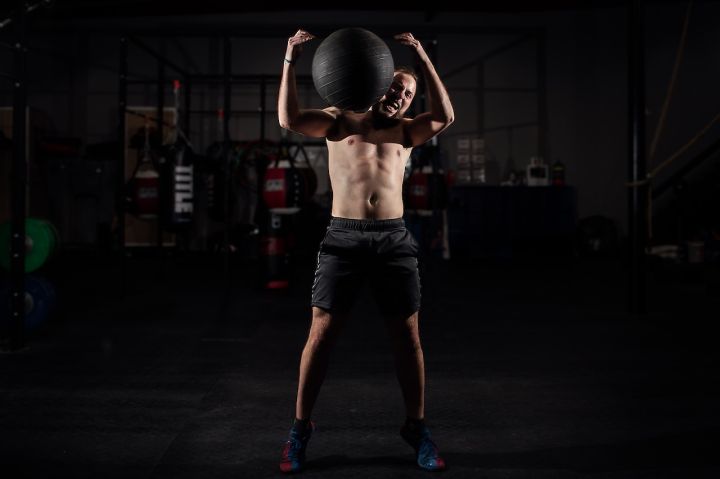Ever since the advent of plunging necklines, bikinis and especially many celebrity outfits, people have been obsessed with the idea of having a flat abdominal figure with six-pack abs. The most common request many fitness trainers hear from their clients is "I want abs!" . Look around the gym and you'll probably see half the people (especially women) doing core exercises such as sit-ups, cycling, planking and using abdominal wheels.

Don't get us wrong, there's nothing wrong with these ab exercises, but having a strong core is much more important. But it's time for us to understand the difference between this abs and core. And appreciate the true function of this ever-important core muscle group.

Your core is your entire body support system
Your core muscles play an important role in your daily activities, from getting up, to walking down the street, to bending down to reach for your purse. But, most importantly, they really help you to stay upright.

That's because your core muscles are the foundation that supports your entire body. They completely surround and support your spine and pelvis, and connect your upper and lower body, effectively transferring power.
Let's review the anatomy
Your abdominal muscles are not just a surface muscle. The deepest abdominal muscle, and arguably the most important, is your transverse abdominis, which stabilises your spine and pelvis. Then you have the two layers of obliques, which control lateral bending (imagine a side bend), rotation and other spinal movements. Last but not least is the uppermost muscle, the rectus abdominis, which is perpendicular to the front of your abdomen and is the six muscle you see. It causes your torso to bend forward.

There are even more muscles involved when you talk about the entire core (not just the abdominals), which also includes: The pelvic floor muscles, the back muscles that stabilise the spine and the diaphragm (the main muscle of breathing).
Whether you are actively exercising or just sitting at a desk, strong core muscles help to maintain a more upright body posture. Think of it as the trunk of your body: It must be anchored to the ground so that your branches (arms and legs) can do whatever they want to do.

Core strength is crucial in every movement you do
When you start exercising, a stable base is very important: "The abdominal muscles play a dominant role in every plane of movement (generally there are three planes): Sagittal (forward and backward), coronal (left and right), and transverse (rotational)".

Normally, the core muscles are activated before we do an activity. Our nervous system anticipates the activity and prepares to support it. When we go to do anything, if you don't have the stability and strength of your core to support your spine, you may be able to compensate with other muscles.
Weak core muscles are the number one risk of potential injury, especially lower back injuries. Studies have shown that core strength training (especially of the deep trunk muscles) can help reduce low back pain.

While back injuries are common in cases of core weakness, you can also injure other parts of your body such as your shoulders, hips and knees as a result. Even if a weak core is not the only cause of a person's injury, it is usually a very important one, which is why core strength improvement is incorporated into many people's post-injury rehabilitation therapy training.
You need to build up sufficient core strength before you can get the rest of your strength up
To a large extent, core strength is an important factor that stops you from completing or continuing an exercise (or fitness movement). Even in training movements where you don't appear to have abs involved.

For example: Do your hips sag when you do push-ups? Is your lower back arched? Is your stomach on the ground first? Do your lower back arches and ribs protrude forward during push-ups?
Does your lower back hurt in a hard pull? Or are you forced to arch forward or stretch your back?

In any of these cases, your core strength may be weak.
This is why many sports, in particular, require core stability and joint flexibility. Building the right foundation will not only help you avoid injury, it will also help you perform better and progress faster. A study on runners found that runners who did six weeks of core strength training significantly increased their speed in a 5,000m run.

You need to activate properly
However, having a strong core is only part of the equation; you also need to know how to use it. Most people look at their core as weak, but usually it's not necessarily a core problem. Their bodies are not in the best position to use them, and they may just not know how to 'activate them'. This may be due to prolonged sitting, hunching, or even hyperextension (which many people consider to be good posture).

It is more about raising awareness of the muscles and once they are able to activate them, it is much easier to activate them in all exercises. Use these tips to learn how to use your core and follow these instructions to ensure that your core is functioning in all your workouts.

However, before you add a lot of russian twists and leg lifts to your workout, be aware that "If repetitions are too frequent or incorrect, such as bending and rotation of the spine (e.g.: Crunches or exercise ball twists), you are at a higher risk of injury. Instead, you should focus on stabilising or counter-rotating movements that will prevent your back from stretching, such as the plank. Surprisingly, doing squats, farmer's walks and push-ups are also a great way to improve core strength, as the core is the main stabiliser and must be actively engaged and kept stable throughout the workout.


